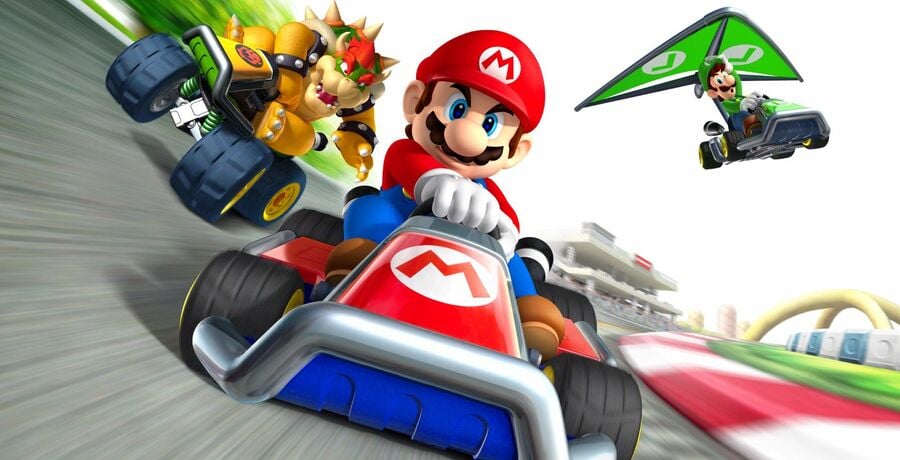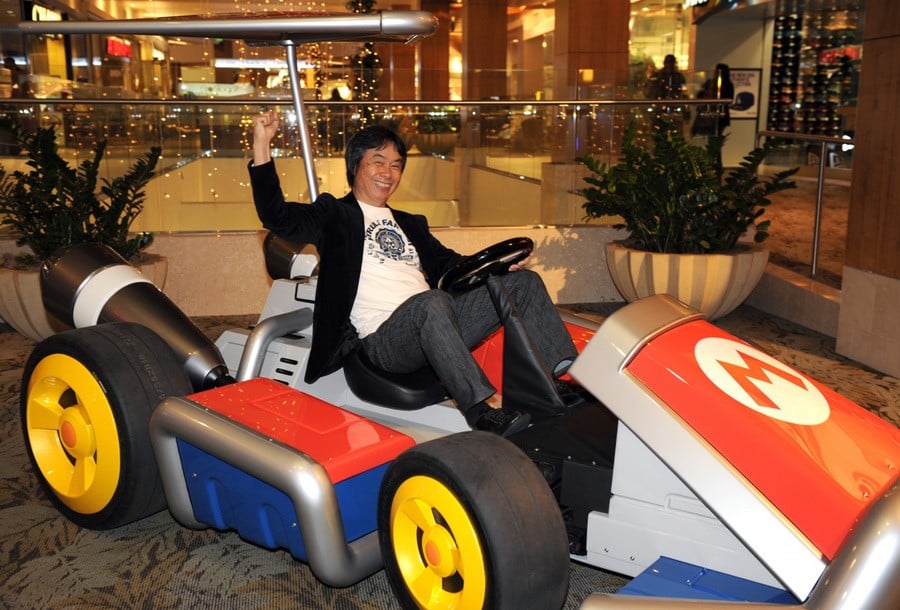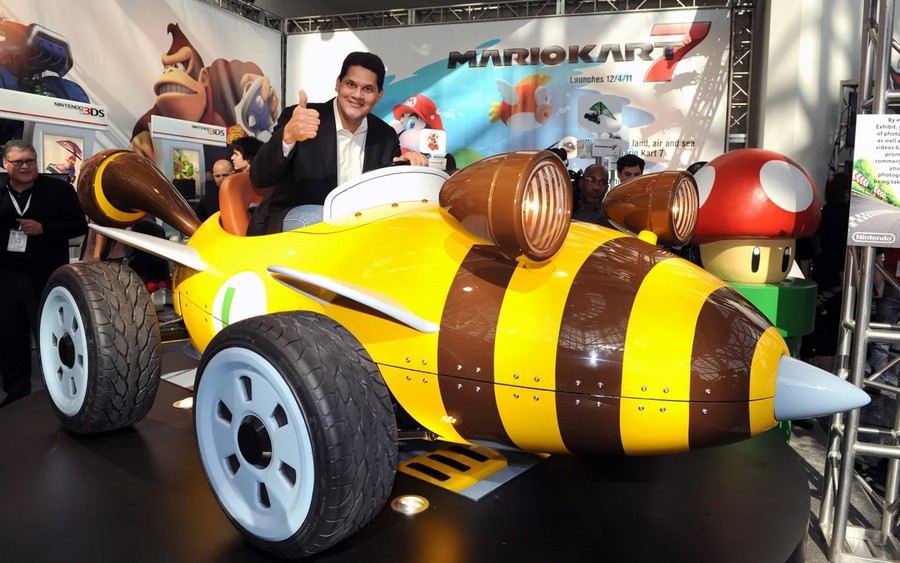
We're in a gaming era of plentiful patches, where it's common for games to get frequent updates starting on day one. There are some rare releases even today that receive either no updates or very few — unless there are frequent DLC additions — and one of Nintendo's selling points is its focus on detail and quality when it comes to shipped games; for the most part, the company releases titles that are pretty much ready-to-go and not "wait for a few updates to fix things" experiences. Its record is far from spotless, but compared to the majority of developers a version 1.0 first-party release from Nintendo will likely be a relatively smooth experience.
Yet as Mario Kart 7 reaches its 10th anniversary we remembered a particular part of that game's rather humorous and, in hindsight, important legacy. It taught Nintendo that, sometimes, you just have to update a game.
 Watch on YouTube
Watch on YouTubeSubscribe to Nintendo Life on YouTube841k
Let's hit pause and, first of all, remind ourselves a little about Mario Kart 7. First of all, the name — it was the first entry in the series to introduce a number, which seemed a little random back then but certainly established a shift for the brand.
Secondly it helped to 'save' the 3DS. The portable endured a poor launch in March 2011, and by that year's Fall / Autumn Nintendo's executives took a major pay cut, the cost of the system was reduced significantly, and early adopters — or 'Ambassadors' — were given 20 free retro games as an apology (10 NES titles that would later come to 3DS Virtual Console, and 10 GBA games that were never officially available on the system by any other means). It was all very dramatic when you consider that Nintendo was coming off the runaway success of the DS and Wii era, and when compared to today's monster profits in the single-platform Switch era.

While Monster Hunter 3 G contributed handily to a late-2011 comeback for 3DS in Japan, the games that joined the price cut for a big push in the West were Super Mario 3D Land and Mario Kart 7. Suddenly a handheld that was initially perceived to be too expensive and lacking in killer apps was neither of those things, and a steady revival towards respectability was underway which would eventually result in one of Nintendo's most enviable software libraries.
It also helped that Mario Kart 7 was rather good — perhaps not 'best in series' level, but definitely fun either locally or online. It had some truly excellent tracks (a few of which were revived in Mario Kart 8 / Deluxe), with standouts including Music Park / Melody Motorway, Neo Bowser City / Koopa City, Wario Shipyard / Wario's Galleon, Rock Rock Mountain / Alpine Pass and a Rainbow Road that we prefer to the MK8 equivalent (it's less annoying, anyway). And yes, for some reason a bunch of tracks had different names depending on whether you were in EU or NA, presumably as a result of some sort of localisation turf war.
It was a period with a lot of firsts, then, as 'Nintendo Network' (the predecessor to Nintendo Account / Switch Online) found its feet and brought the big N kicking and screaming into the 21st Century.
It also moved the series forward in fun ways. Assembling your vehicle with three parts made its debut, as did gliders that helped inform some clever course designs. Online play continued to build on the good work of Mario Kart Wii and added communities, where you could form private lobbies with friends and forum buddies. It had nice little StreetPass and SpotPass features (we still miss them), and let's not forget it was the first MK game that could be downloaded from the eShop, with the 3DS being the first Nintendo system to have retail games available digitally.
It was a period with a lot of firsts, then, as 'Nintendo Network' (the predecessor to Nintendo Account / Switch Online) found its feet and brought the big N kicking and screaming into the 21st Century. There were growing pains, of course, but it was also quite exciting. We even recall the eShop going down on Christmas Day 2011 (which was big news!) as eager new 3DS owners and Mario fans bombarded and crashed the network. Intriguing times.
Mario Kart 7 also established another new trend, as it had a couple of glitches / cheats so bad that Nintendo applied a patch to fix them in online play. It was one of the first times we could recall Nintendo actually issuing a major update to a game; we're aware this is making us sound old...
Like a lot of games MK7 had plenty of glitches and crazy skips that speedrunners and enthusiasts could find, but the issue with one skip in particular was that it was far too easy and completely broke a track. Humorously, there were two like this, including a harder one on Wuhu Loop, and its far more famous brethren Maka Wuhu. Both of these tracks were on Wuhu Island from Wii Sports Resort, and are actually really charming and enjoyable courses; clearly the layout of the tracks led to curious oversights in testing that led to a mini 'crisis' in online play.
Maka Wuhu's glitch was incredibly easy to trigger, as you merely had to drive into the water at a semi-precise point, at which point Lakitu picked you up and dropped you far further along the course — approximately 20 seconds further on. When this started to happen you'd see a few players disappear into the water and their dots then skip ahead on the radar. The internet being what it is, word got around fast and anyone with enough eagerness to read about these things could quickly learn the trick. Suddenly this course transformed, as there'd be races where everyone would dive into the water and skip ahead. It was still a fair race when everyone did it, we suppose, but it sure was silly and against the spirit of the game.
It became normalised to the point that it was the way to complete the track, and Nintendo even said a month after launch that it had no plans to fix it. Then, suddenly, nearly six months after the game's release and a good while after the glitches' discovery, Nintendo issued a patch in May 2012. It stopped the skip (and the less common Wuhu Loop equivalent) in online play. For an entertaining little while, though, not everyone got the memo.
Your humble scribe recalls seeing people diving into the water for a good few weeks after the update, no doubt then baffled when Latiku put them back in the right place. I once even sacrificed a race to watch the spectacle, as some determined racers took a dip, got put back by Lakitu, and then queued up to try it again.

More innocent times, perhaps, but also an early indication that, after initial resistance, Nintendo decided to recognise that not every game is perfect on day one, and that there's no shame in making tweaks post-launch to fix mistakes. In fact, Skyward Sword received its own save data patch for a glitch in the form of a downloadable Wii Channel workaround just before Christmas 2011 — something Nintendo was obliged to fix with a little more alacrity as it was a game-ender.
Nowadays it's commonplace, of course, with Metroid Dread recently issuing a patch that shutdown a tricky speedrunning tactic due to its potential negative impact on normal playthroughs. Maka Wuhu taught Nintendo that, in the world of connected and online gaming, players will find ways to break 'finished' games, and it's better to roll with it and apply fixes.
It was an interesting time, and ultimately Mario Kart 7 did rather well, ending as the best-selling 3DS game on 18.95 million units and having helped the portable achieve a respectable life cycle. It'll forever be in the shadow of its successor across Wii U and, in particular, the Deluxe iteration on Switch — a game so successful that it's still helping to shift record numbers of Switch hardware.
Still, in honour of its first decade, we'll be firing the 3DS entry up for a commemorative dunk in Wuhu river — Happy Birthday Mario Kart 7.
Further reading:





Comments 34
I actually started replaying this game the other day and it holds up remarkably well.
I remember setting a time on the Wuhu track in time trials and my brother was amazed that I was going so fast. Good memories.
I love Mario Kart, one of my favourite series ever, but could never get into MK 7 for some reason. Its course design and gameplay seemed quite a bit worse than MK64, Mario Kart DS, Double Dash, and MK Wii. The classic Mario Kart fun factor seemed strangely absent.
Mario Kart 8 is amazing though, I can see why it's still in the charts to this day.
I loved 7, got it Christmas Day 2011 and promptly completed it Christmas Day 2011. The Wuhu Mountain Loop skip was hilarious!
I'm sorry, I'm still reeling from the fact Mario Kart 7 is already ten years old! 👵🏽
@CharlieGirl Do you mean Mario Kart 7? Mario Kart 8 is 7 years old.
Although maybe ot is my least favourite MK (I think because 3DS was too small and uncomfortable for my hands to play MK) I would like Nintendo to make themed DLCs for MK8DX, eg Mario Kart 7 Pack, Double Dash Pack etc. Such a wasted opportunity. Maybe in MK9.
It's crazy MK8 is almost 10 years old. Oh how Nintendo loves to milk that sweet, sweet cow that is MK8.
Wow, 2011. No wonder my 3ds' battery dies within 15 minutes these days.
"First of all, the name — it was the first entry in the series to introduce a number"
Not true, it was Mario kart 64 😅
Still mighty proud of my 1:17:203 time for Wuhu Mountain Loop. (Also not sure why the video and the article refer to it with its US name.) There were two ways to execute that glitch, though, the one shown in the video is the easier version but was discovered last and is, as far as I know, not the one most people used back in the day. The more difficult version required you to use a mushroom to jump into the water, otherwise it wouldn't register and you'd just get dropped back on the track.
I love the Mario kart series.
It's interesting that the online for this game has been up quite a bit longer than Mario Kart Wii's was.
Mario Kart 7 sure has a lot of localization name changes while Mario Kart 8 has none.
I remember being so confused the first few times I played online and saw half the other players purposely driving off a ledge.
MKDS was farly better imo.
I always preferred DS but this was still fun. That 3D depth effect is outstanding.
WOW! I did not realize it was 10 years already. I remember playing this at launch and then went on a family vacation to the beach. It rained some and between the rain and at night, me and my son played Mario Kart 7 handing the 3DS back and forth to beat all the difficulties and to unlock new parts for the karts. Very fond memories of this game and it still holds up today on the 3DS. Happy 10th anniversary MK7.
I’m pretty sure I’ve never played MK7, weirdly! I loved the original Mario Kart, battle mode was just legendary… I never had an N64, but I have owned Double Dash, Mario Kart Advance, MKDS, MK8 and MK8D. Every one a fantastic iteration, in my opinion.
@Faucet Underrated comment. This blows my mind. The game still looks great, too, as do all of the Wii U era Nintendo games. It goes to show how far strong art direction and intimately knowing the weaknesses and strengths of your hardware can take you.
Hell, Wind Waker HD looks phenomenal and they hardly touched it from the GC release.
"One of the earliest Nintendo game updates we can remember"
Clearly... I am too old for this website. Nice knowing everyone
Great article. I remember those people charging into the water so often. You know something? I never did it. I was happy to play normally. Overall, I'd put MK7 as the third best Mario Kart game. First is MK DS, then MK8D. MK7 does have the best Rainbow Road too.
Super Mario Kart
Mario Kart Advance
Mario Kart DS
Are the best Mario Kart games
This sure was a Mario Kart game alright.
It existed.
I loved the multi - ghost time trials & 1st person view
@Kayvoo Oh wow I forgot about the first-person view, that was pretty cool!
ive never understood the dislike of mk7, is it that much different than 8? i havent gone back to it but i remember when 8 came out, i thought "oh, okay so its more of the same."
i love both games btw.
@Scapetti
do you remember older nintendo updates? i dont, but im certainly "old enough to" if they did happen.
edit - i think im catching mid life crisis from all these other 30 somethings on here acting like they are over the hill. not you, Scapetti, i mean the editors and certain other people. i dont feel like gen x or boomers acted like it was all over at 35. i could be wrong.
25 year olds: "I wasnt even born when SNES came out lul!"
35 year olds: "Im dead."
@ThomasBW84
I was convinced that 1st person view would become a standard option in every subsequent game, I guess it was a one-off to showcase the 3D effect.
@-wc- older games had cartridge revisions. Most people wouldn't be aware but people who had those cheat device things needed to check which version number they had. I guess nintendolife simply meant digital download updates. In which case I guess there's Skyward Sword. But that was an update to the save data rather than the game itself I believe
Ah, the good ol' days when Nintendo supported free online multiplayer.
@Scapetti
yeah, thats what they meant. but i get what you are saying.
@Scapetti There was also the berry glitch patch for Pokémon Ruby/Sapphire before MK7 or Skyward Sword.
It's interesting how those early days of Nintendo game patches usually required some kind of creative workaround to distribute.
I always assumed that suddenly switching to a numbered entry for the 7th version (and later the 8th) was a reference to Microsoft Windows recently doing the same thing.
Ironically, patching Maka Wuhu turned it into one of the best courses in the game, but it was subsequently picked to play a lot less often online.
I can't help but think the people who commit the time to figure out these glitches have minds working on the same wavelength as serial killers.
Show Comments
Leave A Comment
Hold on there, you need to login to post a comment...